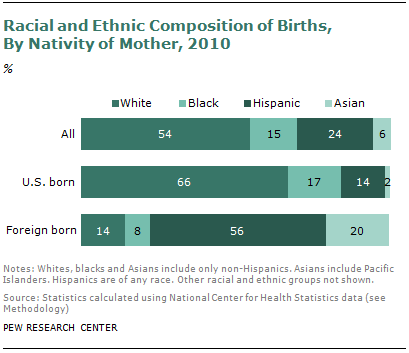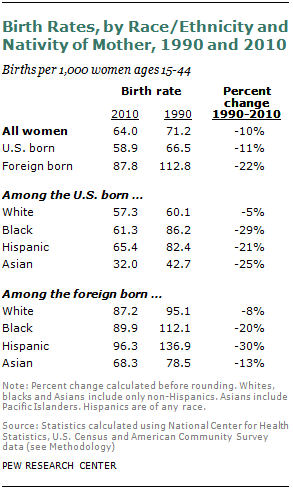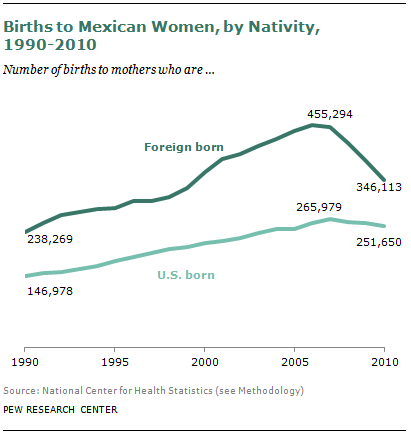
Among mothers of newborns overall in 2010, slightly more than half (54%) were white, 15% were black, 24% were Hispanic and 6% were Asian. But there are marked differences in the racial and ethnic characteristics of births to U.S.-born and immigrant mothers, which are a byproduct of both population makeup and birth rates.
In 2010, 66% of U.S.-born mothers of newborns were white, compared with 14% of new immigrant mothers. Among foreign-born mothers, 56% were Hispanic, compared with 14% of U.S.-born mothers. The share of new mothers who were black was higher among the U.S. born than the foreign born (17% vs. 8%). The share of new mothers who were Asian was higher among immigrants than among the U.S. born (20% vs. 2%).
Since 1990, the share of births to U.S.-born mothers who are white has decreased from 72%, while the share to U.S.-born mothers who are Hispanic has grown from 7%. The racial and ethnic composition of births to foreign-born mothers has changed little. But because births to immigrant mothers have grown, they play a bigger role today in determining the race and ethnic makeup of total births.
Within each race and ethnic group, there also are marked differences in the shares of births to mothers by nativity. Among births to whites, 6% in 2010 were to immigrant mothers, little changed from 4% in 1990. Among births to black mothers, 13% were to immigrants in 2010, up from 7% in 1990. By contrast, the foreign-born share has decreased among Asian and Hispanic mothers. Among births to Asian mothers, 80% were to immigrants in 2010, compared with 86% in 1990. Among births to Hispanics, 56% were to foreign-born mothers in 2010, compared with 61% in 1990.

Generally, the foreign-born population has grown more rapidly, includes more women in their childbearing years and has higher birth rates than the U.S.-born population. But these metrics vary by race and ethnic group.
Both the foreign-born and U.S.-born population of whites have lower shares of women in their childbearing years than do the black, Hispanic and Asian populations.
Among all racial and ethnic groups, Hispanics have the highest birth rates—80 births per 1,000 women of childbearing age, compared with 64 for blacks, 59 for whites and 56 for Asians. The high Hispanic rate is explained in part by the high share of Hispanic women who are foreign born.
In 2010, for each major racial group and for Hispanics, birth rates for foreign-born women were markedly higher than for U.S.-born women. In addition, among immigrant women, whites, blacks and Hispanics had fairly similar birth rates in 2010. Asians had lower birth rates than other racial and ethnic groups, among both foreign-born and U.S.-born women of childbearing age.
Since 1990, the gap in birth rates among whites, blacks and Hispanics has lessened, both for immigrant and U.S.-born women. Among foreign-born women, for example, 1990 birth rates for Hispanics were 44% higher than rates for whites. But the rate for Hispanic foreign-born women declined dramatically after 1990, and the white rate decreased only slightly. In 2010, the Hispanic rate was only 10% higher than the white rate among foreign-born women. The birth rate of foreign-born black women also had been higher than that for white women in 1990, but since then declined more sharply to the point that they are almost equal.
The same general pattern is true for U.S.-born women. Birth rates were markedly higher in 1990 for black and Hispanic women than for white women but now have converged because while the white rate decreased slightly since 1990, rates for the other two groups declined sharply.
Birth rates for foreign-born Asian women of childbearing age declined 13% but remained well below those of the other racial and ethnic groups. Birth rates for U.S.-born Asian women dropped by 25%, and are lower than those of the other major racial and ethnic groups.
As noted previously, births plunged 13% for foreign-born women from 2007 to 2010, after years of rapid growth. This change is especially dramatic for immigrant Hispanics, whose birth numbers dropped 19% from 2007 to 2010. The number of births also was lower in 2010, compared with 2007, for immigrant whites and Asians (although not for immigrant black women).
The decline in births to foreign-born Latino mothers was so sharp that births to Hispanic mothers shrank as a share of all foreign-born births, to 56% in 2010 from 61% in 2007.
For U.S.-born women, births declined 7% from 2007 to 2010 for whites and blacks but rose for Asians (8%) while remaining relatively unchanged for Hispanics (up 1%).

Mexican Mothers
Among Hispanic immigrants, the decline in births to Mexican women was especially large—from more than 455,000 births in 2007 to 346,000 in 2010, a 24% drop. Mexican-born women, who had 43% of births to immigrants in 2007, accounted for 37% of those births in 2010.
Why did births to foreign-born Hispanics, especially Mexicans, decline so abruptly after years of increase? The major reason appears to be a dramatic decline in birth rates. Among all foreign-born women, birth rates declined more from 2007 to 2010 (14%) than they had for the entire 1990-2007 period (10%). For foreign-born Mexican women, birth rates declined nearly as much from 2007 to 2010 (23%) as they had from 1990 to 2007 (26%).
By contrast, the decline in birth rates for U.S.-born women was about the same for the 1990-2007 and 2007-2010 periods—each 6%. (However, a sharper decline was recorded in birth rates for all U.S.-born Hispanic women, down 13% over the 2007-2010 period, and for U.S.-born Mexican women, down 23% (the same as for foreign-born Mexican women), over the 2007-2010 period.)
The number of foreign-born Mexican women of childbearing age did dip slightly after 2007, although this decline was less important a factor than the drop in birth rates. The small decrease in this population occurred during a period of reversal in historic immigration patterns from Mexico. According to a recent Pew Hispanic Center report, net immigration from Mexico—the sum of arrivals and departures—is now zero, and perhaps negative, after years of rapid increases.




